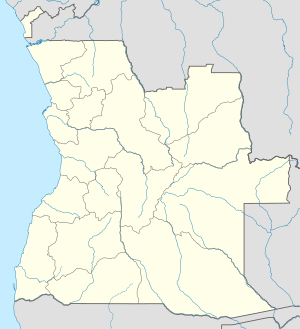
The culture of Angola is influenced by the Portuguese. Portugal occupied the coastal enclave Luanda, and later also Benguela, since the 16th/17th centuries, and expanded into the territory of what is now Angola in the 19th/20th centuries, ruling it until 1975. Both countries share prevailing cultural aspects: the Portuguese language and Roman Catholicism. However, present-day Angolan culture is mostly native Bantu, which was mixed with Portuguese culture. The diverse ethnic communities with their own cultural traits, traditions and native languages or dialects include the Ovimbundu, Ambundu, Bakongo, Chokwe, Avambo and other peoples.

Lunda Norte is a province of Angola. It has an area of 103,760 km² and a population of 862,566. Angola's first President, Agostinho Neto, made Lucapa the provincial capital after independence, but the capital was later moved to Dundo. The province borders the Democratic Republic of Congo in the northeast and Lunda Sul in the south. The province is rich in gold and diamonds, but remains vastly underdeveloped and impoverished. UNITA used the money generated from the sale of diamonds to fund war efforts. Cuango River valley, the richest diamond area of Angola is located in the province. Mining is done by notable companies like DeBeers and Endiama. The Lunda province whose capital was Saurimo was created by the Portuguese colonial empire on July 13, 1895. It was divided into Lunda-Sul and Lunda-Norte subdivisions through a constitution act in 1978 by the People's Movement for the Liberation of Angola (MPLA) government. Iron and manganese mining are also important economic activities. It is well known for its sculptures. The most notable one is The Thinker, a sculpture of a man holding his head. It is rich in terms of flora and fauna.

Lunda Sul is a province of Angola. It has an area of 77,637 km² and a 2014 census population of 537,587. Saurimo is the provincial capital.
The Fucauma Diamond Mine is a diamond mine under construction in the Lunda Norte Province of Angola. The mine is owned by a consortium of diamond mining companies, the two largest holders being Endiama with 40 percent ownership and Trans Hex with 35% ownership.

Saurimo, formerly known as Henrique de Carvalho, is a city in Angola. It is the capital of Lunda Sul Province. As of 2014, Saurimo has a population of 393,000 people, which steadily grows as a result of migration.
Lucapa is a town, with a population of 110,000 and a municipality with a population of 154,305, located in eastern Angola. Lucapa is the former capital of Lunda Norte Province.

Grupo Desportivo Sagrada Esperança, usually known as Sagrada Esperança, is a football (soccer) club from Dundo, Lunda Norte province, Angola. The club won its first title, the Angolan Cup, in 1988.

Girabola, or Campeonato Nacional de Futebol de Séniores Masculinos, is the top division of Angolan football. It is organized by the Angolan Football Federation.
Estádio Sagrada Esperança, formerly Quintalão do Dundo is a football stadium located at the Kamakenzo neighborhood in the city of Dundo, Angola. The stadium underwent a major rehabilitation in 2003 with the installation of a grass pitch to replace the dirt one. On March 5 2008, the stadium was further renovated. It is owned by and the home ground of Grupo Desportivo Sagrada Esperança. The stadium holds 8,000 people.

Endiama E.P. is the national diamond company of Angola and it is the exclusive concessionary of mining rights in the domain of diamonds. Angola's state-run diamond company Endiama produced 8.55 million carats of diamonds in 2010.
Cafunfo is a town, with a population of 90,000 (2014), in North-Eastern Angola dominated by the informal and formal diamond mining industries. The area has numerous alluvial diamond deposits.
The 2000s in Angola saw the end of a 27-year-long civil war (1975–2002) and economic growth as foreign nations began to invest in Angola's untapped petroleum reserves. The government continues to resettle internally displaced persons as its economy recovers and expands.
Mining in Angola is an activity with great economic potential since the country has one of the largest and most diversified mining resources of Africa. Angola is the third largest producer of diamonds in Africa and has only explored 40% of the diamond-rich territory within the country, but has had difficulty in attracting foreign investment because of corruption, human rights violations, and diamond smuggling. Production rose by 30% in 2006 and Endiama, the national diamond company of Angola, expects production to increase by 8% in 2007 to 10,000,000 carats (2,000 kg) annually. The government is trying to attract foreign companies to the provinces of Bié, Malanje and Uíge. Angola has also historically been a major producer of iron ore.
Chokwe is a Bantu language spoken by the Chokwe people of the Democratic Republic of the Congo, Angola and Zambia. It is recognised as a national language of Angola, where half a million people were estimated to have spoken it in 1991; another half a million speakers lived in the Congo in 1990, and some 20,000 in Zambia in 2010. It is used as a lingua franca in eastern Angola.

The Cuango or Kwango is a transboundary river of Angola and Democratic Republic of Congo. It is the largest left bank tributary of the Kasai River in the Congo River basin. It flows through Malanje in Angola. The Kwango River basin has large resources of diamonds in the Chitamba-Lulo Kimberlite Cluster in Lunda Norte Province, discovered in the main river channel and on flats and terraces in its flood plains.
The 2014 Taça de Angola was the 33rd edition of the Taça de Angola, the second most important and the top knock-out football club competition in Angola, following the Girabola. Benfica de Luanda beat defending champions Petro de Luanda 1–0 in the final to secure its first title.

The Republic of Angola and the Democratic Republic of the Congo share a 2,646 km border.
Esmevânio Kialonda Gaspar, sometimes known as just Gaspar, is an Angolan footballer who plays as a centre-back for Primeira Liga club Estrela da Amadora.










